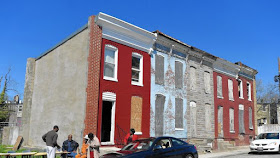 |
| Demolition begin, the chicken mural still in place (Photo: K Philipsen) |
I was the last tenant of 1 w north avenue. I wish people would stop waxing nostalgic about it. It was a disaster. NYFC used to dump their grease in the basement. The walls were collapsing. The basement flooded every winter. I look forward to seeing the new building go up!
 |
| and then it was gone (Photo: K Philipsen) |
The renovated Theatre will be the home of Jed Dietz' Maryland Film festival. A new structure at the corner is part of the rebirth and used as a screening space. The new facility will feature three screens in those two buildings with 600 seats compared to the Parkway’s once 1,100 which had already once been reduced to 420 in favor of more comfortable seats. There will be also a live performance space. Southway is the contractor for the work.
The project was first submitted in 2012 as part of a response to a Request for Proposals by BDC. Earlier BDC requests for proposals had not succeeded in a viable project.
It had been held up several times for lack of money, in one case because of uncertainty about New Market Tax Credits. The project t received a big boost from a $5 million donation of the Stavros Niarchos Foundation.
 |
| The latest rendering of Ziger Snead depicting the corner screening facility and the renovated Parkway Theatre, home of the MD Film Festival. |
As any modern design does in Baltimore, Ziger Snead's replacement of the "Chicken Coop" has provoked snarky comments by those who don't care for stark reductionist modernism. Asked if the blank surface will be used for projections as early renderings suggested, Steve Ziger explained for this article:
The intent is that the corner building, through it's simplicity and minimalism, intentionally contrasts with its context, declaring a new energy at this important intersection. You'll be able to see through the corner lounge to the rough brick wall of the Parkway. We could imagine projected images onto the exterior, but the technology isn't currently part of the project.
The Parkway will be another strong anchor on the Station North segment of North Avenue which has already seen the adaptive re-use of a warehouse which became MICA's Fred Lazarus Center and its School for Social Design, the opening of the Motor House, a much splashier version of what had been the "Load of Fun" before, a larger and much more visited Red Emma's cafe and bookstore, Liam Flynn's Irish bar and music venue and recently the new Impact Hub in the renovation of the Centre Theatre building. Joe Square Pizza upgraded from the corner at Howard Street to the corner of Maryland Avenue. In all, these three blocks of North Avenue can barely be recognized and are a sign that philanthropy, entrepreneurship, and arts and culture are alive and well in Baltimore.
North Avenue in its entire length is in desperate need of attention. City and MTA recently submitted an application for a TIGER grant to the federal government which envisions streetscape improvements and transit acceleration. The City also has money in the budget for improvements at the intersection of Penn and North.
Klaus Philipsen, FAIA
 |
| The Parkway as photographed by Marchand and Meffre |
 |
| An earlier rendering by Ziger Snead shows a different base and the concept of projections on the new addition |
 |
| The theater has retained much of its ornate 1915 interior (Photo: K Philipsen) |











































